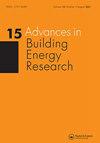Experimental and numerical investigation of eco-friendly materials for building envelope
IF 2.5
Q2 CONSTRUCTION & BUILDING TECHNOLOGY
引用次数: 3
Abstract
ABSTRACT This work aims to evaluate the impact of new materials on thermal performance and energy savings. Indeed, this study shows the importance of the use of natural and recycled waste-based feather materials. For this purpose, a full-scale cell located in Casablanca was considered as a case study to build a simulation model performed on TRNSYS. This model is then used for the impact of the techniques studied on energy performance, GHG emissions, and hours of discomfort inside another cell in Casablanca. This study showed that the developed nonwovens exhibit excellent insulation performance with thermal conductivity in the range of 0.031–0.044 [W/m. K]. Moreover, the minimum energy performance is observed for developed wool insulation with a performance of 30 (KWh/year.m2). The comparison of these values with the Moroccan thermal regulation which sets a threshold of 40 (kWh/year.m2) for the annual thermal load of residential buildings in the climatic zone of Casablanca, shows that the feather waste insulation integrated into the building is mainly sufficient to meet the requirements of Moroccan regulations. Annual GHG emissions are mitigated by 44.61 for FC1, 46.54 for FC2, 47.95 for FC3, 46.59 for FW1, 46.99 for FW2 and 48.58 for FW3(%).环保型建筑围护材料的试验与数值研究
摘要本工作旨在评估新材料对热性能和节能的影响。事实上,这项研究表明了使用天然和回收的废物羽毛材料的重要性。为此,位于卡萨布兰卡的一个全尺寸细胞被视为一个案例研究,以建立在TRNSYS上进行的模拟模型。然后,该模型用于研究技术对卡萨布兰卡另一个牢房的能源性能、温室气体排放和不适时间的影响。该研究表明,所开发的非织造布表现出优异的绝缘性能,热导率在0.031–0.044[W/m.K]范围内。此外,观察到性能为30(KWh/year.m2)的开发羊毛隔热材料的最低能源性能。将这些值与摩洛哥热法规进行比较,摩洛哥热法规为卡萨布兰卡气候区的住宅建筑的年热负荷设定了40(KWh/year.m2.)的阈值,表明建筑中集成的羽毛垃圾隔热材料主要足以满足摩洛哥法规的要求。FC1、FC2、FC3、FW1、FW2和FW3的年GHG排放分别减少了44.61、46.54、47.95、46.59、46.99和48.58(%)。
本文章由计算机程序翻译,如有差异,请以英文原文为准。
求助全文
约1分钟内获得全文
求助全文
来源期刊

Advances in Building Energy Research
CONSTRUCTION & BUILDING TECHNOLOGY-
CiteScore
4.80
自引率
5.00%
发文量
11
 求助内容:
求助内容: 应助结果提醒方式:
应助结果提醒方式:


